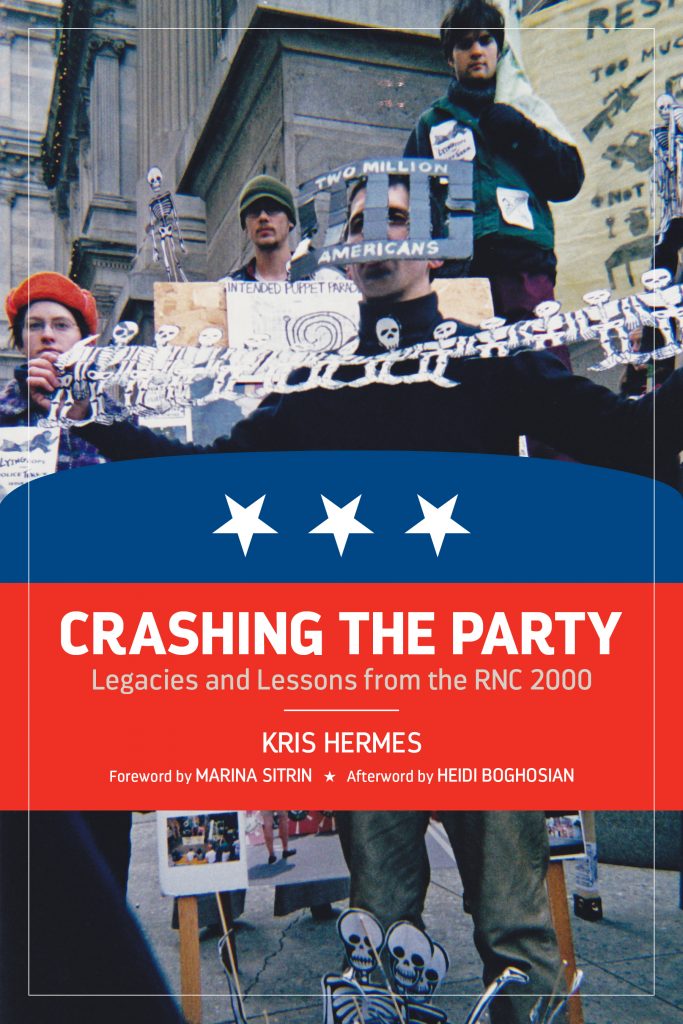by Irina Ceric
Radical Criminology
November 2016
Just as activists tend to take the availability of legal support for granted, so have both social movement writers and scholars tended to ignore the work of providing radical legal support, particularly the contributions of non-lawyers. In Crashing the Party, long-time activist and legal worker Kris Hermes takes on two tasks aimed at overcoming these erasures. This unique book provides what is arguably the first in-depth examination of radical legal support in North America, an analysis framed by his meticulous recounting of the mobilization against the Republican National Convention [RNC] held in Philadelphia, Pennsylvania in the summer of 2000. To tell both stories, Hermes recounts the organizing that culminated in days of creative and diverse actions against the RNC as well as the repressive police tactics deployed against the protesters, tactics which continue to serve as a blueprint for protest policing. What makes Crashing the Party distinctive, however, is its focus on the court solidarity organized by the R2K Legal Collective, a group made up of legal workers, lawyers, law students, defendants and activists. As a result, Hermes documents the emergence of jail and court solidarity and radical legal support as forms of collective action, neglected legacies of the global justice movement.
That the 2000 RNC protest was undoubtedly one of the all too brief series of mobilizations that made up what we now refer to as the global justice movement—a moment that continues to exert a hold on the imagination of the North American left, particularly as younger generations of activists (re)discover this history—is one reason to publish (and read) a book about a now 15 year old struggle. But the 2000 RNC protest was also—and remains—a unique example of radical legal organizing, one we can and should learn from in order “to preserve our shared legacy of political and legal resistance”, as Hermes argues. (8) These lessons would be even more accessible if the book’s depiction of the 2000 RNC was not so detailed. Crashing the Party is almost too ambitious, combining an exhaustive, action-by-action retelling of that summer’s resistance while also discussing many aspects related to movement history in the US more generally (e.g. histories of surveillance, infiltration, and judicial intervention in policing practice and policy—sometimes going back decades). Nonetheless, the result is a work that ought to be read by a wide audience, activists themselves as well as academics interested in social movements, policing, state repression, and critical legal studies.
Hermes’ central argument is that “[b]ecause of mistreatment on the streets and in jail, as well as the excessive charges applied to hundreds of protesters, the RNC 2000 arrestees sought vindication in the courtroom, spurring a court solidarity strategy that began with a mass refusal to accept plea bargains and a mass demand for trials.” (7) More contentiously, he contends that the tactics underlying this strategy (“activists staging political trials, overcoming charges, exposing widespread surveillance and infiltration, raising unprecedented funds for legal defense, and using media to shift public opinion”) have never been used together since. (8)
Recent examples in Ontario (the 2010 Toronto G20) and Quebec (student strikes and anti-austerity protests since 2012) suggest otherwise, as most if not all of these court solidarity tactics were used in fighting charges arising from these recent mobilizations. This oversight is at least partly due to the book’s US focus, although Canadian law collectives are included in the list of radical legal collectives compiled by Hermes.
Regardless of the uniqueness of R2K Legal’s strategy, however, Crashing the Party’s comprehensive account of radical legal support from the perspective of legal organizers is not only valuable as movement history but also provides a glimpse into the political tensions underlying activists’ interactions with law and the state. Hermes engages with issues long debated by progressive lawyers and legal scholars on the complex dynamics between legal and political activists, particularly questions of strategy, knowledge, and decision-making power that inevitably arise during interactions between legal professionals and the movements they support. The book contains many instructive, grounded stories of such interactions, not all of them pleasant or productive. The civil suits that resulted from the RNC arrests however, do illustrate a successful attempt at creating “a new way for activists (both plaintiffs and supporters) and lawyers to work together collectively” through the use of consensus decision making and extensive discussions in which everyone affected would be heard. (201)
Crashing the Party also explores key questions that anyone who has participated in direct actions will immediately recognize. For instance, how do we challenge legal support fatigue or a lack of faith in jail solidarity (suspicion that often threatens to become a self-fulfilling prophecy)? (232) He reminds us that it is “crucial that we assess the state’s resources, strategies, and tactics, as well as its limitations and vulnerabilities” when thinking about legal responses, offensive and defensive. The 2000 RNC protest serves as a potent example of how movements can grow and develop new capacities not despite repression, but in resistance to it, learning “ways in which we might gain collective strength against the state.” (12) As someone who has been involved in providing radical legal support for the better part of two decades, such reminders, especially coupled with Hermes’ critical yet hopeful analysis of the promise—and perils—of radical legal activism, serve as a much-needed validation. Legal support is no one’s favorite organizing role, but the work is both necessary and generative: “Arguably, it is in the realm between the legal world and the world of political organizing where, when boundaries are pushed, unexpected results can occur.” (228)







